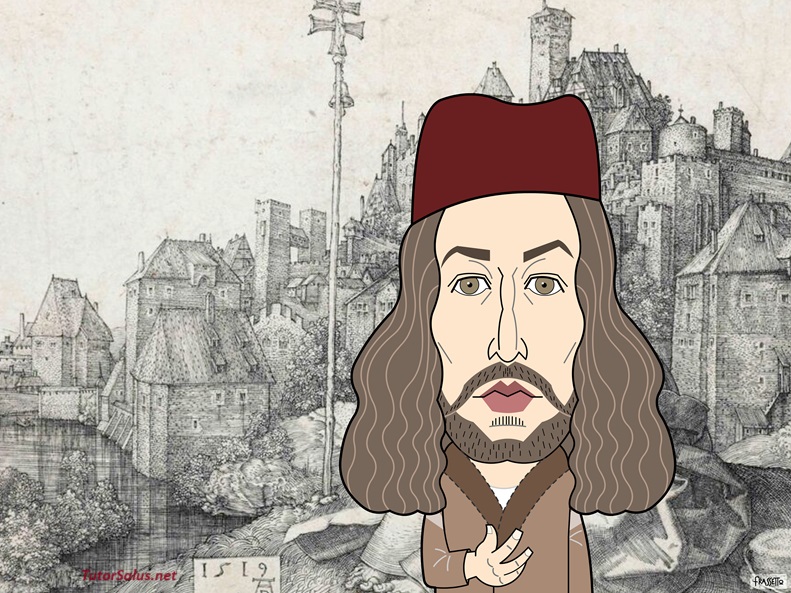Albrecht Dürer[1].
The effectiveness of beauty in reality.

Original painting by Stefano Frassetto (5).
“What the beauty is I don’t know… There isn’t one that is not susceptible to further refinement…”[2]
Dürer was not an isolated genius but a cultured man, well introduced in the German society from which, however he could take distance with that refined expertise which made him a reliable interlocutor of those powerful patrons who called him, and without attracting the distrust which instead his contemporary Leonardo Da Vinci surrounded himself.
Son of the goldsmith Albrecht, named ‘the Elder’[3], since childhood Dürer was an excellent draftsman and with a keen talent for portraiture : soonest he began to cooperate wth scholars and printers in the nascent and promising editorial environment in Nuremberg, until he decided to switch to the difficult – and impressive – art of engraving, to which he would even entrusted the fold of the face of a mocked Christ in ‘Passion’ (1497-1510), and also the perverse shades of envy on the men in ‘Christ at twelve among the Doctors’ (1506).
However it was the religious question of that period, between the emerging Protestant Reformation – maybe launched by a loan of the Fugger Family to the Archduke of Tyrol in 1487, granted by a mortgage on the silver mine of the Archduke – and the following Counter-Reformation, which started in Dürer man a question not to be disregarded, the one of a unique individual thinking, not divisible between rationalism and mysticism, uniqueness that is removed only through short-sightedness, making the human turn pale into a rigid servile dull mechanicalness which, shifting and shifting, will be culminating into the Nazi insanity of a few decades ago.
It is a most severe criticism by Dürer, even is well-educated, hardly counterable due to its captivating sophistication, against the German and contemporaries artists, first of them the brilliant politician Lucas Cranach, piainter of Reformation and friend of Martin Lutero with whom Dürer was cooperating at the beginning. Just look at the different interpretations of St. Jerome, a model for the humanists at the crossroads between Protestants and Catholics.
The art of Dürer came to face the art of our Leonardo Da Vinci, for whom the old age of St. Jerome was only penance and loneliness, while Dürer was describing a saint and smiling old man, gladly aware.
In his own loyalty to the classsic canons, re-examined thanks to the rediscovery of artists like the painter Apelle, named by Plinius the Elder as capable to reproduce visually sounds and scents, Dürer enjoys the extraordinary individuals painted by Giorgione, Tiziano, Lotto and by Leonardo Da Vinci himself building in turn on the excellent Italian Colleagues’ achievements. He’s prepared the ‘Renaissance’ indeed, through his proverbial curiosity towards a real he deemed reliable even in his own old age, and in the effort of life that can always be processed.
At last he landed to his most puzzling work, “Melencholia” of 1511, where the leading character is the artist himself, as a processor of reality, without any other satisfaction than the work itself and the work in progress indeed. Dürer daringly themes the artist ‘fury’ as he can investigate the desorder of the world coming even to establish an order[4] thanks to the tools of logic at his disposal, but then he is alone when anticipates his contemporaries concluding a work that is inviting, for the world itself wants and is disposed to it, even if is still a project and not yet an experienceable reality.
Loneliness breeds ‘melencholy’ Dürer suggests, while pointing out the risks of a modern Ideal of sexual autonomy, already present in the authors of ‘Reformation’.
The liking of Dürer for the perfect monstrosity of “ Marine crab” (1495) which lets be admired without resistance is that of a curious man and fond of reality, not contaminated by prejudices but attentive student of the classic and measurable canons.
It is the same liking which you find again in “The satyr family”(1505), a ‘faun’ as wild as tender husband as well as a caring father in a quite different family compared to that where the educational rigour forges indeed risky weaknesses and inhibitions ready to explode.
Finally, it is an application sympathy, the one focusing the mistrustful judgement of Dürer towards an emerging social submission in Europe – favoured by the Culture of the contemporary ‘Reformation’ by Martin Lutero, to whom however Dürer will approach in the last years of his life – ready to generate real monsters, pale and lucid executors of anything they don’t share nor love, hating the even mild individuality of a child when he asks questions to which the adult has given up answering.
Marina Bilotta Membretti / Cernusco sul Naviglio – September 8, 2018
[1] I owe the discovery of Albrecht Dürer (Nurberg 1471-1528) to a welcome surprise by my daughter : the visit to the exhibition in Milan “Dürer ed il Rinascimento fra Germania ed Italia” (a cura di B. Aikema) at ‘Palazzo Reale’ (February 21 – June 24, 2018).
[2] “Dürer”, edited by Costantino Porcu – Rizzoli Editore Milano (2004)
[3] It is of 1490 the “Portrait of Albrecht Dürer, the Elder”.
[4] “Ordine, contrordine, disordine. La ragione dopo Freud”, Maria Delia Contri – SIC Edizioni (2016) : the author specifically deals the theme of ‘disorder’ which precedes and supports any psychopathology.
(5) Stefano Frassetto is born in Turin in 1968. After his degree in Architecture at ‘Politecnico’ he begun as graphic novelist for local magazines. In the ‘90s he edited in France too, on ‘Le Réverbère’ and on ‘Libération’ : then he created ‘Ippo’ for ‘Il Giornalino’ and then the stripe ‘35MQ’ for the swiss magazine ‘20 Minuti’. In 2000 he came into ‘La Stampa’ as portraitist for cultural page and the insert ‘Tuttolibri’, then for the weekly ‘Origami’. Today he works also for the swiss magazine ‘Le Temps’.

